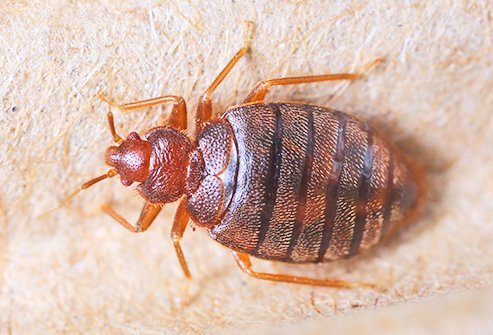How to Tell if You Have Chiggers or Bed Bugs

If your itchy bites are keeping you up at night, you may be trying to figure out what’s biting you. While their bites may look similar, there are key differences between chiggers and bed bugs.
Chiggers
Chiggers are found in clusters and feed on your body for several hours or days until you wash or scratch them off. You may feel them on your skin but cannot see them due to their microscopic size.
Bed bugs
Bed bugs tend to live near where you sleep. Look for the following signs in your bed sheets or mattresses:
- Little spots of blood
- Rusty-looking stains (crushed bugs)
- Black dots
- Live bugs around the seams or tags
| Chiggers | Bed bugs | |
|---|---|---|
| Appearance |
|
|
| Feeding habits | Feed on humans and animals | Feed on humans, other mammals, and birds at least once every 14 days |
| Living conditions | Active when the ground temperature is between 77-86 degrees F | Survive and remain active at temperatures as low as 45 degrees F |
| Hiding places |
|
|
| Bites | Itchy, red bumps that can look like pimples, blisters, or small hives | Itchy, red bumps similar to mosquito bites or flea bites |
What are symptoms of chigger vs. bed bug bites?
Chiggers
Symptoms of chigger bites typically start 1-3 hours after a bite:
- Itching that gets more severe over time
- Small, red, flattened or raised pustule or blister
- Grouped in clusters around areas of your body where you wear tight clothing, such as the elastic of underwear or around your sock line
- Skin lesions resolve after 2 weeks
Bed bugs
Symptoms of bed bug bites occur a few days or up to 2 weeks after a bite:
- Itching
- Similar appearance to mosquito bites or flea bites
- Raised, inflamed, red bumps
- Clustered or zigzag formation
Bed bug bites may also cause:
- Sleeping trouble
- Anxiety
- Skin irritation
Some people may be extremely sensitive to chigger bites or bed bug bites and experience symptoms similar to severe allergic reactions (anaphylaxis).
How do chiggers vs. bed bugs bite?
Chiggers
After hatching, baby chiggers try to attach to a person or animal using their tiny claws. Once attached, they insert feeding structures into your skin, injecting saliva that contains digestive enzymes that dissolve the surrounding skin cells. Chiggers then feed on the dissolved skin cells until they get sufficient protein to turn into an adult. After a few days, the chigger detaches, leaving a red bump on the skin.
Bed bugs
You likely won’t feel a bed bug bite since they inject an anesthetic and anticoagulant into your skin when they bite. As a result, you may not notice the bite marks until it appears after a couple of days.

